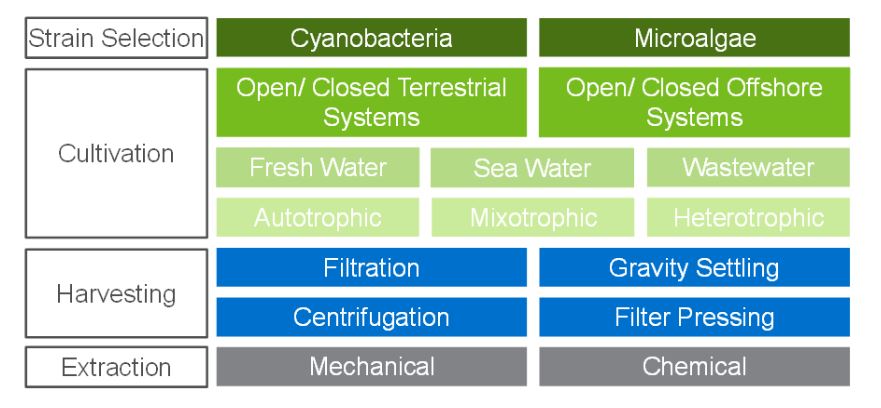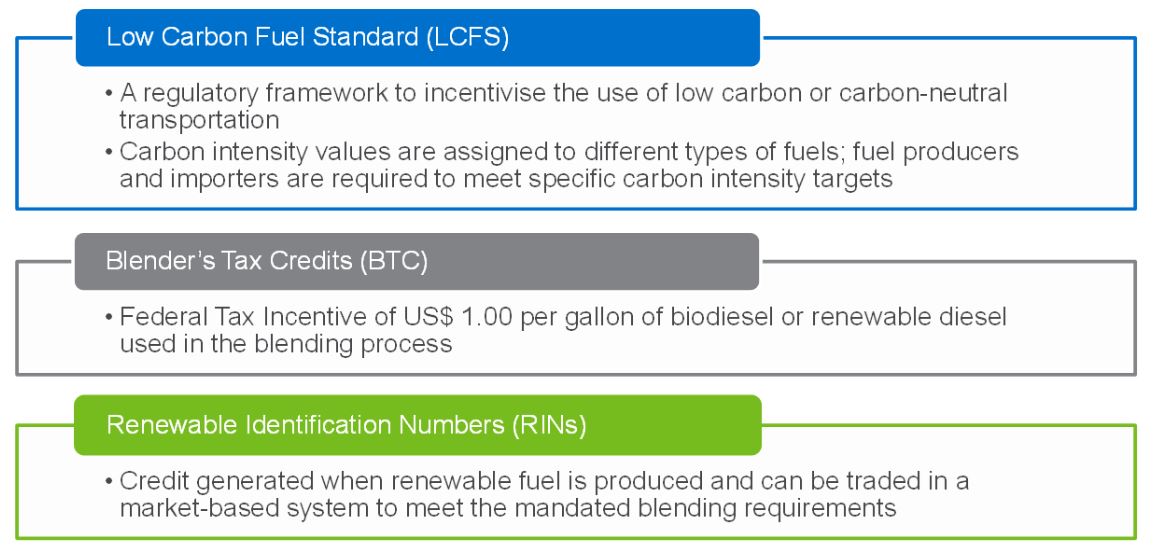Algae’s potential as a sustainable feedstock/product

As the world work towards reducing greenhouse gas (GHG) emissions and transition towards cleaner energy sources, carbon-neutral or carbon-negative energy sources have been explored. One such avenue is algae-based fuels, which like any other plants, absorb carbon dioxide from the atmosphere as they grow. Its high lipid (oil) content can then be converted into biodiesel or polysaccharides (carbohydrates) that can be converted to biogas or bioethanol. There are also other alternative uses for algae beyond fuel production that could contribute to GHG reduction by potentially substituting other products such as fertilizers that are conventionally produced from non-renewable sources.
Figure 1.1 Algae End Uses
Algae End Uses
While algae has similarities to other plants, with the key one being natural carbon sinks, there are a few reasons why algae has garnered more interest as a plant-based source. Algae can:
Grow in brackish water and wastewater streams
Form part of a wastewater treatment system to produce clean water while terrestrial plants consume it
Double its volume of biomass in mere hours under appropriate conditions
Be used as a biofuels feedstock generator as well as a direct producer of biofuels and chemicals; they are known for lipids production because algae are uniquely capable among green plants of producing lipids throughout the biomass (not only in seeds)
Be widely cultivated for extractable byproduct animal feed, food protein isolate, vitamins, other nutraceuticals, oleochemicals feedstocks, colourants etc.
One of the most compelling reasons behind the interest towards algae-based fuels is their lower carbon intensity when compared to conventional fossil fuels. Their inherent carbon capture capability results in reduced greenhouse gas emissions throughout the production cycle of algae-based fuels, making them an attractive alternative to traditional fossil fuels if the economics prove workable.
Algae’s carbon impact in reality
The primary determinant for achieving successful commercial production of algae-based fuels is tied to the level of oil productivity. The pathway for generating algae oil is remarkably adaptable, offering a range of avenues that span from selecting the appropriate strains, choosing cultivation techniques, and refining the processes of harvesting and extraction. The economic feasibility of microalgae biofuels hinges on the ability to cultivate these microorganisms on a large scale in outdoor settings.
This cultivation can take place in open systems like ponds and wastewater facilities, as well as enclosed offshore setups such as photobioreactors (PBR). Among these options, open pond systems are the simplest from a technical standpoint, utilizing atmospheric carbon dioxide for operation. However, atmospheric carbon dioxide is insufficient to facilitate the rapid growth of algae needed for efficient biofuel production. Conversely, PBRs require an external supply of carbon dioxide due to their inherent design which can potentially be sourced from industry flue gases.
The autotrophic growth (i.e. via photosynthesis) of algae is dependent on availability and intensity of light which becomes a limitation in regions with limited or consistent sunlight. This limitation affects the scalability and productivity of algae cultivation. On the contrary, heterotrophic growth relies on external organic compounds like sugars. However, this approach increases operational costs and limits the versatility of algae cultivation as not all species are capable of heterotrophic growth. A middle ground is found in the mixotrophic growth mechanism, which combines the advantages of both cultivation methods while mitigating their drawbacks. This approach is being embraced by companies like Next Generation Oil in Malaysia, where they employ the mixotrophic growth mechanism in their patented modular algae cultivation system known as Algae-Modular Automated Plantation (A- MAPTM).
Algae’s carbon impact in reality
In order to properly assess the true carbon benefits of algae-based fuel against conventional fossil-based fuel, it is thus important to understand the differences in production approaches for algae. As mentioned earlier, heterotrophic cultivated algae rely on sugars rather than photosynthesis and thus ends up exhibiting the highest carbon intensity among the algae production methods. Roughly two-thirds of the carbon emissions from heterotrophic algae cultivation are attributed to scope 3 emissions from dextrose, a component of the raw materials, which emit approximately 1.2 tons of CO2e per ton of whole algae. In contrast, autotrophic cultivation methods such as open pond and photobioreactor have lower carbon emissions as they consume carbon dioxide for photosynthesis.
It is also worth noting that although algae cultivated via the autotrophic route reduces carbon emissions through the absorption of carbon dioxide from the atmosphere, the process is not without carbon emission. Algae cultivated this way typically contains higher water content, necessitating more energy for the dewatering and drying processes. Energy is primarily supplied through fuel gas combustion, which is the primary source of carbon emissions in autotrophic cultivation methods, followed by power consumption.
Advancement in biotechnology – the answer to algae oil productivity for biofuels?
Despite ongoing endeavors to enhance algae cultivation techniques for boosting oil productivity, the advancement of biotechnology will be necessary to unlock the full potential of algae-based fuels. Researchers and scientists are continually refining cultivation techniques, optimising algae strains for higher lipid content (which translates to greater fuel yield) and improving overall productivity.
Genetic engineering and synthetic biology are at the forefront of biotechnological breakthroughs in algae-based fuel production. By modifying algae strains or identifying optimum algae growth environments to enhance their lipid production capabilities, researchers are accelerating the transition from laboratory innovations to scalable, commercial solutions. These advancements not only enhance the environmental credentials of algae-based fuels but also pave the way for increased efficiency and cost-effectiveness. Viridos, previously known as Synthetic Genomics has been focusing on algae genomic research in the last decade to improve oil productivity through gene modification and identifying a robust algae strain. While Viridos is currently not at the stage of achieving commercial production of algae biofuels, the company has notably been one of the few algae companies that still has its focus on producing algae fuels.
Credits fueling algae-based fuels
Credits serve as catalyst for advancement and play a pivotal role in propelling the development and utilisation of algae-derived fuels. These credits, encompassing a range of environmental, economic and regulatory incentives, are shaping the landscape of renewable energy by providing a foundation upon which this industry can flourish.
Fiscal incentives are implemented in the United States to promote the use of renewable fuels in the transportation sector. These include the blender’s tax credits (BTC), Renewable Identification Numbers (RINs) and Low Carbon Fuel Standard (LCFS). While BTC and RINs are applicable for the whole country; LCFS legislation is enacted in selected states such as California, Oregon and Washington.
Credits fueling algae-based fuels
Find out more…
Biorenewable Insights: Algae Technology (2023 Program)
This BI report provides an overview of the biology, production routes, economics and applications of algae in the conventional energy industry.
The Authors…
Caleb Chong, Managing Consultant
Miu Shan, Koo, Senior Analyst


